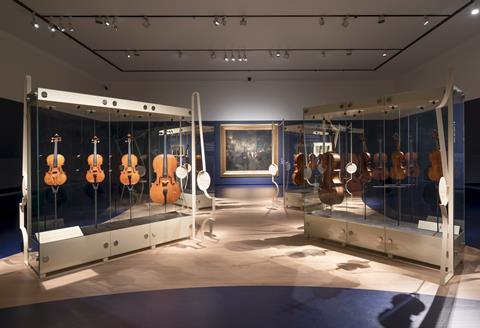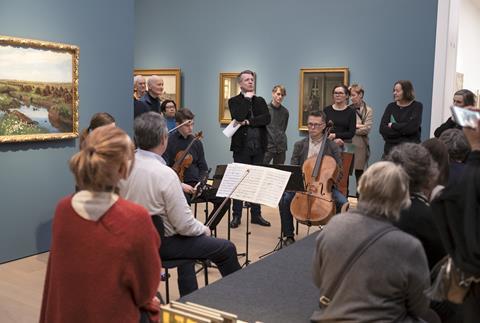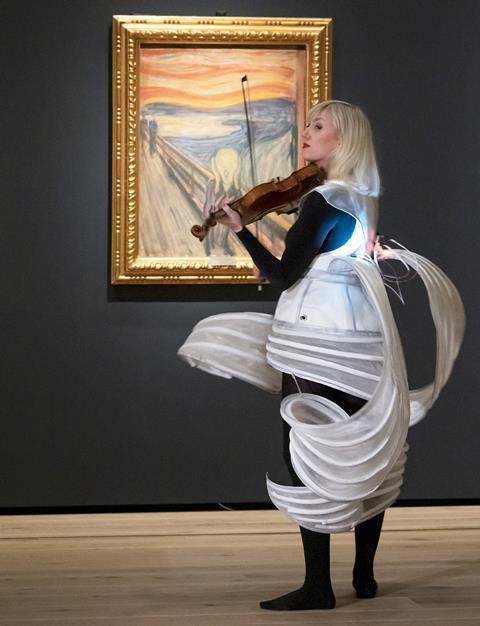Musicians, luthiers and experts converged on Oslo’s National Museum in February for ‘Master to Master’, a feast for the eyes, ears and brain. Christian Lloyd reports on a full-on celebration of fine instruments

Discover more lutherie articles here
Read more premium content for subscribers here
The first four notes of ‘Morning’ from Grieg’s Peer Gynt are based on the tuning of a Hardanger fiddle’s understrings. Andrea Guarneri was so annoyed at his son Pietro leaving Cremona for Mantua that he wrote him out of his will. And Matteo Gofriller tended not to label his instruments, so he could avoid paying the Venice taxes. These were among the myriad factoids to be gleaned from the ‘Master to Master’ symposium, a celebration of historic stringed instruments that took place in Oslo from 11 to 13 February this year. The conference brought musicians, luthiers, bow makers and dealers from across Europe to the Norwegian capital, then covered in a thin blanket of snow – the harbour around the Oslo Opera House was still frozen over, while children could be seen ice-skating on the fountains.
The conference came in the middle of a two-week exhibition at Oslo’s new National Museum, opened in 2022. It was organised by Dextra Musica, which since 2006 has been collecting some of the finest stringed instruments in the world as charitable investments for the DNB Savings Bank Foundation. The collection now numbers over 120 instruments and many of the treasures were on display at the exhibition. Each day saw at least three concerts take place, all curated by a string player, in and around the rooms of the museum. I arrived in time to see one of these performances in the main foyer: the Vertavo Quartet was performing next to a ‘wheel of fortune’, with a piece of music assigned to each of the 24 stopping points.

The exhibition itself was conceived as a way to combine the twin aesthetics of music and art, with the instruments displayed alongside paintings. Most notably Peder Severin Krøyer’s 1886 painting of the Neruda Quartet, Music in the Studio, featured alongside the real stars of the show: four quartets of instruments by Antonio Stradivari, G.B. Guadagnini, the Guarneri family and the Gofriller family. Other treasures included the Gasparo da Salò violin once owned by Norwegian virtuoso Ole Bull, the only known double bass by Girolamo Amati II (see In Focus, August 2021) and some beautifully decorated Hardanger fiddles. The two rooms proved to be a mecca for the assembled luthiers, who were eagerly scrutinising the bee-stings and neck roots with their pocket torches.
The symposium itself, however, began in an unexpected way: not about lutherie at all, but with a discussion of the first five bars of Mozart’s ‘Dissonance’ Quartet K465. Eric Wen, Juilliard lecturer (and former editor of The Strad ), gave a lively presentation arguing that a detailed discussion of such a short section was akin to a luthier analysing the curves of a particular Guarneri f-hole. This was followed by Carlo Chiesa’s lecture on Cremonese making in the 17th and 18th centuries (‘when I was asked, I wondered how many days they’d give me!’) It concluded with what he called the most important piece of information he could give: it’s pronounced ‘del jeZOO’, not ‘del JAYzoo’!
Read: Collection of violin expert Norman Rosenberg fetches £4.7 million at auction
Read: US National Music Museum begins reopening project
Discover more lutherie articles here
Read more premium content for subscribers here
Duane Rosengard gave the next presentation remotely from New York, after which Stefano Pio discussed the Gofriller family. The first instrument Matteo is known to have made is a viola da gamba dated 1689, which led Pio to tell me afterwards his theory that the viol as we know it evolved in Venice, rather than from the Aragonese vihuela de arco. Finally, Balthazar Soulier presented his findings on Cremonese varnish, already familiar to The Strad ’s readers from his article in October 2021.
That evening we had the first of the ‘all-star’ concerts, featuring a dozen instruments by G.B. Guadagnini together on stage. Introduced by Atle Sponberg, concertmaster of the Norwegian Radio Orchestra, the evening also featured the likes of violinists Stephan Barratt-Due and Marianne Thorsen, and cellist Torleif Thedéen (playing the 1783 cello that Dextra bought in 2019 for £1.93 million, a record for a Guadagnini). The highlight was an arrangement of the Handel–Halvorsen Passacaglia followed by a joyous rendition of Monti’s Csárdás by all the musicians on stage together – a unique treat for the eyes and ears.
Luthiers were eagerly scrutinising the bee-stings and neck roots with their pocket torches
The next day began with a lecture on the history of Norway’s national instrument, the Hardanger fiddle. Although the earliest surviving example is dated 1651, it appears the history goes back much further; luthier Wiebke Lüders showed us a 13th-century bridge for a five-stringed instrument discovered in Oslo, and discussed the theory that fiddles with resonance strings may have existed on the British Isles as early as the end of the 16th century, and then brought to Norway. John Dilworth, the exhibition’s curator, continued the British connection by arguing that in the 18th century, the epicentre of violin culture was London, given the number of wealthy merchants and traders collecting fine instruments at the time. He also suggested that the 1689 ‘Arditi’, owned by Dextra, could have been made as part of the famed set made by Stradivari for the Medici court, partly because of the faint ‘S’ monogram on the neck root.
We were privileged to hear the ‘Arditi’ in concert that evening, played by Oslo Philharmonic concertmaster Elise Båtnes. For me, the undoubted highlight of the evening was the rendition of Schubert’s String Quintet op.163 on five Strads. Båtnes performed with fellow violinist Eldbjørg Hemsing (1707 ‘Rivaz’), violist Eivind Ringstad (1734 ‘Gibson’) and cellists Robert Max (1726 ‘Saveuse’) and Louisa Tuck (the ‘Suggia’ Stradivari). Quite apart from the once-in-a-lifetime chance to hear a full Stradivari quintet, the performance was masterly, all five musicians responding to one another, and the performance by turns graceful, forceful, plangent and moving. As they took their bows, all five players looked energised by the experience as the audience were brought to their feet.

Sunday was a more informal day, with the lectures taking place at the ‘Sentralen’, a cultural centre run by the foundation. Here we learnt more on the Hardanger fiddle, after which Alberto Giordano gave a presentation on Italian art. Apparently, at the famous 1987 Guarneri exhibition in New York, dealer Francois Denis commented that ‘if “del Gesù” had been an artist, he’d have been Van Gogh.’ Renato Scrollavezza took exception to this, and exclaimed, ‘Nonsense, he’d have been Magnasco!’ His reasons were their common disregard for conventional beauty, the spirit of modernity they embodied, and the evident speed at which they worked. The evening’s entertainment was supplied on instruments of the Gofriller family, along with a 1735 Carlo Bergonzi owned by Dextra. More earthy than the Strads and with perhaps a little less colour, the instruments gelled together in Grieg’s Quartet no.27, with Øyvind Gimse in particular bringing a full-bodied throaty sound from his cello.
Exhilarating and exhausting in equal measure, the three days in Oslo were an experience not to be missed. The luthiers I spoke to declared themselves fascinated by the exhibition and its various events, and the organisers are to be congratulated on their efforts to bring so many scholars and experts, as well as Norway’s performing elite, all together in one place. If there’s ever another such event in the future, a three-day pass is a must.
Read: Something to smile about: Postcard from Poznań
Read: Postcard from Kerteminde: Chamber Music at Lundsgaard
Discover more lutherie articles here
Read more premium content for subscribers here
The number one source for playing and teaching books, guides, CDs, calendars and back issues of the magazine.
In The Best of Technique you’ll discover the top playing tips of the world’s leading string players and teachers. It’s packed full of exercises for students, plus examples from the standard repertoire to show you how to integrate the technique into your playing.
The Strad’s Masterclass series brings together the finest string players with some of the greatest string works ever written. Always one of our most popular sections, Masterclass has been an invaluable aid to aspiring soloists, chamber musicians and string teachers since the 1990s.
This year’s calendar celebrates the top instruments played by members of the Australian Chamber Orchestra, Melbourne Symphony, Australian String Quartet and some of the country’s greatest soloists.

































![[1st prize] Poiesis Quartet in round 3 (2)](https://dnan0fzjxntrj.cloudfront.net/Pictures/100x67/1/9/5/41195_1stprizepoiesisquartetinround32_547631.jpg)











No comments yet